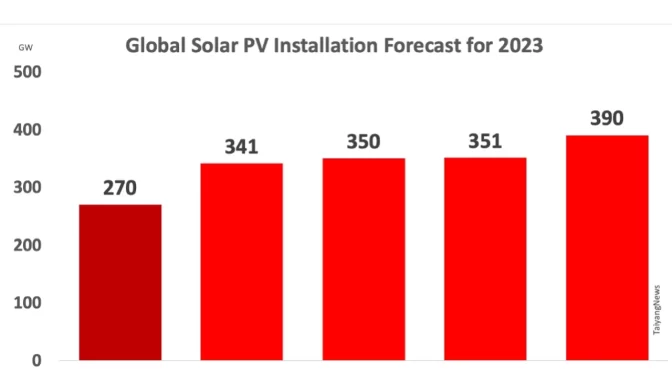Solar photovoltaic and battery storage to make up 81% of new U.S. electric-generating capacity in 2024

Data source: U.S. Energy Information Administration, Preliminary Monthly Electric Generator Inventory, December 2023
Developers and power plant owners plan to add 62.8 gigawatts (GW) of new utility-scale electric-generating capacity in 2024, according to our latest Preliminary Monthly Electric Generator Inventory. This addition would be 55% more added capacity than the 40.4 GW added in 2023 (the most since 2003) and points to a continued rise in industry activity. We expect solar to account for the largest share of new capacity in 2024, at 58%, followed by battery storage, at 23%.
Solar. We expect a record addition of utility-scale solar in 2024 if the scheduled 36.4 GW are added to the grid. This growth would almost double last year’s 18.4 GW increase, which was itself a record for annual utility-scale solar installation in the United States. As the effects of supply chain challenges and trade restrictions ease, solar continues to outpace capacity additions from other generating resources.
More than half of the new utility-scale solar capacity is planned for three states: Texas (35%), California (10%), and Florida (6%). Outside of these states, the Gemini solar facility in Nevada plans to begin operating in 2024. With a planned photovoltaic capacity of 690 megawatts (MW) and battery storage of 380 MW, it is expected to be the largest solar project in the United States when fully operational.
Battery storage. We also expect battery storage to set a record for annual capacity additions in 2024. We expect U.S. battery storage capacity to nearly double in 2024 as developers report plans to add 14.3 GW of battery storage to the existing 15.5 GW this year. In 2023, 6.4 GW of new battery storage capacity was added to the U.S. grid, a 70% annual increase.
Texas, with an expected 6.4 GW, and California, with an expected 5.2 GW, will account for 82% of the new U.S. battery storage capacity. Developers have scheduled the Menifee Power Bank (460.0 MW) at the site of the former Inland Empire Energy Center natural gas-fired power plant in Riverside, California, to come on line in 2024. With the rise of solar and wind capacity in the United States, the demand for battery storage continues to increase. The Inflation Reduction Act (IRA) has also accelerated the development of energy storage by introducing investment tax credits (ITCs) for stand-alone storage. Prior to the IRA, batteries qualified for federal tax credits only if they were co-located with solar.
Wind. Operators report another 8.2 GW of wind capacity is scheduled to come on line in 2024. Following the record additions of more than 14.0 GW in both 2020 and 2021, wind capacity additions have slowed in the last two years.
Two large offshore wind plants scheduled to come on line this year are the 800-MW Vineyard Wind 1 off the coast of Massachusetts and the 130-MW South Fork Wind off the coast of New York. South Fork Wind, which developers expected to begin commercial operation last year, is now scheduled to come on line in March 2024.
Natural gas. For 2024, developers report 2.5 GW in planned natural gas capacity additions, the least new natural gas capacity in 25 years. Notably, in 2024, 79% of the natural gas capacity added is to come from simple-cycle, natural gas turbine (SCGT) plants. This year will be the first time since 2001 that combined-cycle capacity was not the predominant natural gas-fired technology. SCGT power plants provide effective grid support because they can start up, ramp up, and ramp down relatively quickly.
Nuclear. Start-up of the fourth reactor (1.1 GW) at Georgia’s Vogtle nuclear power plant, originally scheduled for last year, has moved to March 2024. Vogtle Unit 3 began commercial operation at the end of July last year.

Data source: U.S. Energy Information Administration, Preliminary Monthly Electric Generator Inventory, December 2023
Principal contributor: Suparna Ray


